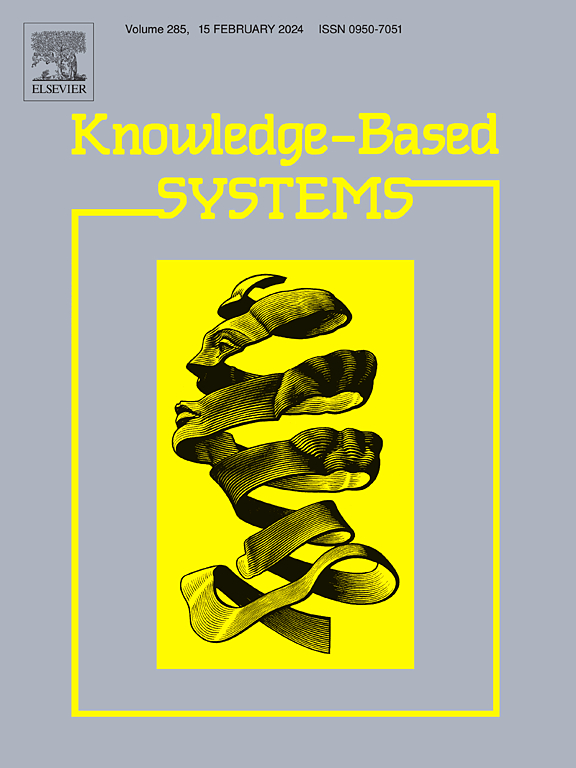面向复杂网络的多类型多关系异构图神经网络模型
IF 7.6
1区 计算机科学
Q1 COMPUTER SCIENCE, ARTIFICIAL INTELLIGENCE
引用次数: 0
摘要
网络是现实社会中普遍存在的一种关系,利用图和图神经网络(gnn)对这些网络建模并捕捉它们的特征关系显示出巨大的发展潜力。由于网络中节点和边缘关系的固有复杂性,异构图神经网络(hgnn)已成为首选的建模方法。然而,现有的hgnn主要关注节点之间只有单一关系的异构图,这限制了它们处理具有多个关系交互的复杂网络图的能力。为了有效捕获网络中的复杂节点对象和多关系交互,本文提出了一种多类多关系异构图(MMHGNN)神经网络模型,该模型由结构特征编码、加权多关系路径聚合和特征融合三个模块组成。在结构特征编码模块中,MMHGNN利用四色定理对图进行上色,生成沿路径边关系的类型编码,将颜色特征与路径编码合并,作为不同路径的结构特征,从而增强复杂关系和结构下节点的可分辨性。在加权多关系路径聚合模块中,MMHGNN以节点间边关系的个数作为权重对路径上的邻居进行聚合,并采用均衡策略防止长路径上的权重过大。在特征融合模块中,MMHGNN将来自结构特征编码的结构特征与来自关系聚合模块的嵌入相结合,利用图级关注机制融合不同路径上的节点特征并生成最终的节点嵌入。在实际复杂网络数据集上进行的实验表明,MMHGNN在多任务上具有显著优势。本文章由计算机程序翻译,如有差异,请以英文原文为准。
A multi-typed multi-relational heterogeneous graph neural network model for complex networks
Networks are a prevalent relationship in real-world society, and the use of graphs and graph neural networks (GNNs) to model these networks and capture their characteristic relationships has shown tremendous development potential. Due to the inherent complexity of node and edge relationships within networks, heterogeneous graph neural networks (HGNNs) have become the preferred modeling approach. However, existing HGNNs primarily focus on heterogeneous graphs with only single relationships between nodes, which limits their ability to handle complex network graphs with multiple relational interactions. To effectively capture the complex node objects and multi-relational interactions in networks, this paper proposes a neural network model for multi-class multi-relational heterogeneous graphs (MMHGNN), consisting of three modules: structural feature encoding, weighted multi-relation path aggregation, and feature fusion. In the structural feature encoding module, MMHGNN employs the Four Color Theorem to color the graph and generates type encodings of edge relationships along paths, merging color features with path encodings to serve as structural features for different paths, thereby enhancing the distinguishability of nodes under complex relationships and structures. In the weighted multi-relation path aggregation module, MMHGNN aggregates neighbors along paths based on the number of edge relationships between nodes as weights and implements a balancing strategy to prevent excessive weights on long paths. In the feature fusion module, MMHGNN combines the structural features from the structural feature encoding with the embeddings from the relation aggregation module, leveraging a graph-level attention mechanism to fuse node features across different paths and generate the final node embeddings. Experiments conducted on real-world complex network datasets demonstrate the significant advantages of MMHGNN across multiple tasks.
求助全文
通过发布文献求助,成功后即可免费获取论文全文。
去求助
来源期刊

Knowledge-Based Systems
工程技术-计算机:人工智能
CiteScore
14.80
自引率
12.50%
发文量
1245
审稿时长
7.8 months
期刊介绍:
Knowledge-Based Systems, an international and interdisciplinary journal in artificial intelligence, publishes original, innovative, and creative research results in the field. It focuses on knowledge-based and other artificial intelligence techniques-based systems. The journal aims to support human prediction and decision-making through data science and computation techniques, provide a balanced coverage of theory and practical study, and encourage the development and implementation of knowledge-based intelligence models, methods, systems, and software tools. Applications in business, government, education, engineering, and healthcare are emphasized.
 求助内容:
求助内容: 应助结果提醒方式:
应助结果提醒方式:


